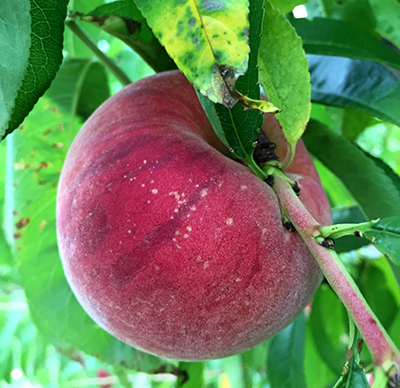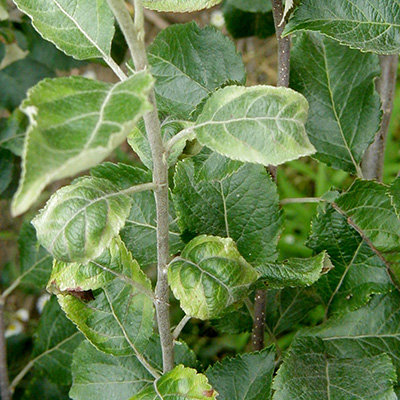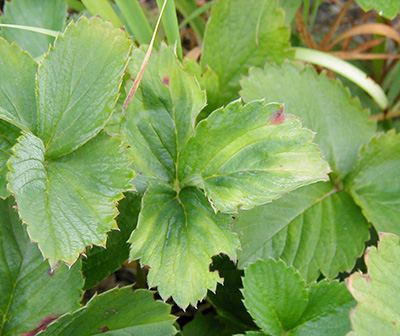Southwest Michigan fruit update — July 25, 2017
Summer insect pests are becoming real problems for many growers.

Weather
Last week was warm and humid, with highs in the 80s and lows in the 60s. Scattered showers moved across the region Thursday, Friday and Saturday (July 20-22). Most of the rain fell in the southern tier of counties, which received 0.5 to 0.8 inch of rain. The more northern counties received less rain, between 0.2 and 0.3 inch of rain.
Heavier soils are moist and sandy soils are generally dry. Rainfall this season has been very uneven. Comparing this season’s rain across southwest Michigan shows an average of over 12 inches; some site have had less than 8 and others more than 15 inches of rain since April 1. Last week’s potential evapotranspiration was about 1.4 inches of water for a season total of 19 inches since April 1.
This week will start cool with less humidity and highs in the 70s. Warm conditions will return with highs in the 80s and a chance of showers late Wednesday night through Thursday. The weekend should be cool and dry. We are about a week ahead of normal for heat accumulation and crop harvests for this date.
|
Southwest Michigan GDD summary from Jan. 1 – July 23, 2017 |
|||
|---|---|---|---|
|
Station |
GDD 42 F |
GDD 45 F |
GDD 50 F |
|
Benton Harbor (SWMRC) |
2592 |
2147 |
1600 |
|
Lawton (Lawton33) |
2447 |
2090 |
1554 |
|
Fennville (TNRC) |
2283 |
1935 |
1424 |
|
Average for the SW region |
2465 |
2101 |
1566 |
|
Ave from March 1 |
2368 |
2034 |
1533 |
|
Accumulation last week |
213 |
192 |
157 |
Tree fruit
The summer generations of many insect pests are emerging or damage is appearing in orchards. Japanese beetles are a problem in some locations. San Jose scale on the fruit are causing red spots. Brown marmorated stink bugs are still nymphs and not yet flying. Brown marmorated stink bug damage to crops is still very low. Review the in sect trap catch at Trevor Nichols Research Center. Young plantings on sandy sites may need irrigation again soon. Leaf samples for foliar tissue analysis should be collected from mid-July to mid-August. Tissue samples should be sent to A&L labs.
Peach growers are harvesting the pre-Redhaven varieties including Early Red Haven, Summer Serenade and PF 8 Ball. Redhaven harvest will start next week for central Berrien County. Other peach varieties harvesting with Red Have include PF-9A, Starfire, PF Lucky 13 and PF 11 Nectarine.
Quality continues to be good with only minor disease problems and some bird peck issues on dark skin varieties. To increase fruit color, do some light summer pruning one to two weeks before harvest on varieties needing more color.
Leaf drop and fruit spotting due to bacterial spot is becoming more obvious. Oriental fruit moth trap catch is up and down. We are in the second oriental fruit moth flight. Egg hatch for the second-generation oriental fruit moth began about June 25. Stink bug and tarnished plant bug damage can increase fruit susceptibility to brown rot. As fruit begins to color, the need for brown rot protection increases. Rotate fungicide classes used for brown rot control to avoid resistance problems.

White speckles on peach fruit from spread of bacterial spot bacteria from infected leaves above. Photo by Bill Shane, MSU Extension.
Cherry harvest has ended in southwest Michigan. Cherry leaf spot is a serious problem in some orchards. Chlorothalonil can be used after harvest to help suppress cherry leaf spot with low risk of resistance buildup by the
Early plum harvest continues with Shiro. Protect fruit from spotted wing Drosophila (SWD), which does attach thin-skinned Japanese plums. Ripen plums also need to be protected from brown rot. Apple maggot can also attack plums, but SWD sprays should control this pest.
Apples range from 1.5 (Gala) to 2.5 (Zestar) inches in diameter. Reapply fungicides to reduce sooty blotch and flyspeck as rains wash off fungicide coverage. Fruit entries by oriental fruit moth larvae of the second generation are scarce. Codling moth trap catches increased last week in many locations. This increase indicates the second generation of codling moth flight has begun. Obliquebanded leafroller larvae are feeding on foliage.
Apple maggot is a summer apple pest, which emerges after a rain and attacks apples. Apple maggot trap catch numbers are up. The insecticides you are using need to control all the insects attacking your fruit.
Potato leafhopper injury is showing up on apple shoot tips. Woolly apple aphid aerial colonies and bronzing of leaves by European red mites are becoming easier to find.

Potato leafhopper symptoms on apple, commonly called hopper burn. Note the yellowing of the leaf edges and sectional yellowing of the leaves. Severely affected leaves will also curl downwards. Photo by Mark Longstroth, MSU Extension.
Pear (Bartlett and Harrow Sweet) fruit are 1.5 inches in diameter. A minimal spray program will help to hold sooty blotch and fly speck in check. Pear psylla levels seem low.
Small fruit
Grape clusters have filled out. Downy mildew and powdery mildew incidence is still low. A few infections of phomopsis and black rot are present. Berries are resistant to new disease infections until veraison. Early varieties should begin veraison in the next week or two.
Generally, grape leafhopper in juice grapes and potato leafhopper in wine grapes are not a problem. Japanese beetle numbers are low. We are still several weeks away from the beginning of third generation grape berry moth egglaying. Most vineyards have set fruit despite the frost damage this spring. A significant portion of this fruit is being borne on secondary shoots.
SWD catch is higher this year than previous years. SWD will likely be a problem after veraison, especially in wine grapes. Hang traps for SWD and treat after veraison if necessary.
Blueberry harvest is in full swing with the second pickings of Bluecrop. Hand harvest and machine harvest are moving quickly. Some growers are using machines because of a shortage of pickers. Fruit quality is variable as growers struggle to remove ripe fruit quickly.
In the last few weeks, SWD numbers have really jumped. We are seeing SWD numbers as high as we normally see in August. Tight spray schedules are needed to control SWD. Protecting ripe fruit is very hard. Even with excellent insecticide programs, the longer ripe fruit stays in the field, the more likely it is to be attacked by SWD.
Tight harvest schedules reduce the time ripe berries are exposed to SWD. Do not neglect fungicides. Fruit rots such as anthracnose and alternaria have been reported. Phomopsis canker and cane collapse is easier to find. In the next month, collect leaf samples for foliar tissue analysis. Foliar analysis give a much better picture of the nutrition in the plant. Soil sample reveal what is in the soil, but not what the plant needs to optimize growth and yields.
Bramble harvest continues. Summer red raspberries are abundant and harvest will continue for several more weeks. Black raspberry harvest is ending and blackberry harvest is beginning. The high SWD numbers have put real pressure on raspberries and blackberries one of their favorite hosts. Protect fruit from SWD. See MSU’s recommendations for SWD control in brambles for more information. One of the best defenses is to pick as often as you can, removing ripe fruit as quickly as possible.
Strawberry fields are showing good regrowth after renovation. Protect renovated plantings from potato leafhopper, which stunts plant growth. Irrigate renovated strawberry fields to get good growth for next year.

Potato leafhopper damage to strawberry leaves. Note the yellowing of the leaves where the leafhoppers have injected a toxin into the leaf. Photo by Mark Longstroth, MSU Extension.
Upcoming meetings
The 28th Annual Viticulture Field Day and Steak Cookout is Wednesday, July 26. The event, hosted by the Michigan Grape Society and Michigan State University Extension, is at the Southwest Michigan Research and Extension Center.
An open house at the Southwest Michigan Research and Extension Center is Tuesday, Aug. 15, from 1 p.m. to 4:30 p.m. Project tours of vegetable, tree fruit, bramble and blueberry research will take place. There is no charge for admission, but please pre-register.
The Michigan Grape Society is hosting its next Grower Social on Aug. 16 at 3 p.m. We will be meeting the Round Barn Winery. The event includes an educational segment by MSU Entomology. Registration is $15 and includes a light supper and wine.
See also
- Plan to change when dealing with spotted wing Drosophila
- Southwest Michigan fruit update – July 18, 2017
- Michigan spotted wing Drosophila report for July 18, 2017
- Tissue analysis for monitoring fruit nutrition
- Post-harvest cherry leaf spot applications
- SDHI fungicides for protecting fruit from brown rot infection
- Potato leafhopper control in wine grapes
- Control of pre- and post-harvest fruit rots in blueberries
- Post-bloom fungicide choices in blueberries



 Print
Print Email
Email




